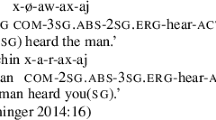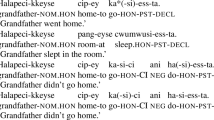Abstract
We examine the realization of subject and object agreement in Kadiwéu, where there is only one prefixal position, and neither subject nor object can consistently be said to win—rather, the person and number of the arguments matters. We argue for an analysis in terms of the markedness of the 1st person compared to the second, dispreferring 1st person realization. This analysis is complicated by the fact that 1st person plural does in fact win over 2nd person, but only when it is an object. This turns out to be a consequence of the fact that the 1st plural object prefix is a portmanteau fusing person and number. The properties of the exponent inventory, combined with the morphological resources of Kadiwéu (understood here in terms of Trommer’s (2008) Coherence constraints) and its independent need for inverse marking thus conspire to yield the particular set of argument realization combinations. We argue that factoring out the analysis into feature-sensitive realization of the feature [+participant] and [+plural], dispreferred realization of marked [+author], and these morphotactic coherence constraints, provides a better analysis of crosslinguistic variation and language-internal facts than positing an autonomous language-specific hierarchy to encode the facts.
Similar content being viewed by others
References
Anderson S. (1992) A-morphous morphology. Cambridge University Press, Cambridge
Beavers, J. (2006). Argument/Oblique alternations and the structure of lexical meaning. Doctoral dissertation, Stanford University.
Béjar S., Rezac M. (2009) Cyclic agree. Linguistic Inquiry 40(1): 35–73
Bobaljik J., Branigan P. (2006) Eccentric agreement and multiple case-checking. In: Johns A., Massam D., Ndayiragije J. (eds) Ergativity: Emerging issues. Springer, Dordrecht, pp 47–77
Braggio, S. (1981). Aspectos fonológicos e morfológicos do Kadiwéu. Master’s thesis, UNICAMP, Brazil.
Calabrese A. (2005) On absolute and contextual syncretism: Remarks on the structure of paradigms and how to derive it. In: Bachrach A., Nevins A. (eds) The bases of inflectional identity. Oxford University Press, New York, pp 156–205
Calabrese, A. (2009). On the shyness of the first person (this volume).
Cooreman A. (1994) A functional typology of antipassives. In: Fox B., Hopper P. (eds) Voice: Form and function. John Benjamins, Amsterdam, pp 50–87
Farkas, D., & Kazazis, K. (1980). Clitic pronouns and topicality in Rumanian. In Chicago Linguistic Society (Vol. 16, pp. 75–82). Chicago: Chicago Linguistic Society.
Hale, K., & Keyser, S. J. (Ed.) (1993). On argument structure and the lexical expression of syntactic relations. In The view from building 20 (pp. 53–109). Cambridge, MA: MITWPL.
Halle, M. (1997). Impoverishment and fission. PF: Papers at the Interface, MITWPL (Vol 30, pp. 425–450). Cambridge, MA: MITWPL.
Halle M., Marantz A. (1993) Distributed morphology and the pieces of inflection. In: Hale K., Keyser S.J. (eds) The view from building 20. MITWPL, Cambridge, MA, pp 111–176
Halle, M., & Marantz, A. (1994). Some key features of distributed morphology. In MITWPL 21: Papers on phonology and morphology (pp. 275–288). Cambridge, MA: MITWPL.
Harbour, D. (2009). On descriptive and explanatory markedness (this volume).
Harley H., Ritter E. (2002) Person and number in pronouns: A feature-geometric analysis. Language 78(3): 482–526
Hiraiwa, K. (2001). Multiple agree and the defective intervention constraint in Japanese. In The proceedings of the MIT–Harvard joint conference (HUMIT 2000), MITWPL (Vol. 40, pp. 67–80). Cambridge, MA: MITWPL.
Ito J., Mester A. (2003) Japanese morphophonemics: Markedness and word structure. MIT Press, Cambridge, MA
Kawasaki, H. (1982). An acoustic basis for universal constraints on sound sequences. Doctoral dissertation, UC Berkeley.
Kibrik A. (1990) As línguas semanticamente ergativas na perspectiva da Tipologia Sintática (originally Semantitcheskie ergativnye jazyki v perspektive Sintaksitcheskoj Tipologuii, translation by Lucy Seki). Cadernos de Estudos Linguísticos 18: 15–36
Kiparsky P. (2001) Structural case in Finnish. Lingua 111: 315–376
Marantz A. (1993) Implications of asymmetries in double object constructions. In: Mchombo S. (eds) Theoretical aspects of Bantu grammar. CSLI Publications, Stanford, pp 113–150
McGinnis M. (2005) On markedness asymmetries in person and number. Language 81(3): 699–718
Müller, G. (2006). Extended exponence by enrichment: Argument encoding in German, Archi, and Timucua. Paper presented at the Workshop on Theoretical Morphology, Leipzig.
Nevins A. (2007) The representation of third person and its consequences for person-case effects. Natural Language and Linguistic Theory 25(2): 273–313
Noyer, R. (1992). Features, positions and affixes in autonomous morphological structure. Doctoral dissertation, MIT.
Sandalo, F. (1995). A grammar of Kadiwéu. Doctoral dissertation, University of Pittsburgh.
Sandalo, F. (1997). A grammar of Kadiwéu with special reference to the polysynthesis parameter. MITOPL 11, distributed by MIT Working Papers in Linguistics.
Steele S. (1995) Towards a theory of morphological information. Language 71(2): 260–309
Trommer J. (2008) Coherence in affix order. Zeitschrift für Sprachwissenschaft 27(1): 99–140
Wunderlich D. (1997) Cause and the structure of verbs. Linguistic Inquiry 28: 27–68
Author information
Authors and Affiliations
Corresponding author
Rights and permissions
About this article
Cite this article
Nevins, A., Sandalo, F. Markedness and morphotactics in Kadiwéu [+participant] agreement. Morphology 21, 351–378 (2011). https://doi.org/10.1007/s11525-010-9165-2
Received:
Accepted:
Published:
Issue Date:
DOI: https://doi.org/10.1007/s11525-010-9165-2




